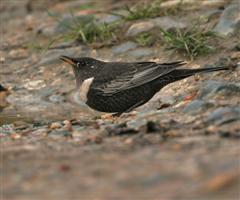Ouzel - Ring
Scientific Name: Turdus torquatus
Sat, 12th July, 2025 - 4:20 am GMT
Sponsor Ads:

Alternative Name
Scientific Name: Turdus torquatusBasic Info
Most Ring Ouzels have yellow bills. The female has more brown plumage than does the male. The feathers of the female's underside and the flight feathers of both sexes have edging that makes them appear scale-like. Usually, the underside of the Ring Ouzel is pale. Males may have a crescent shaped white bib. Although the crescent bib may also present in some females, it is usually dirtier in coloration or less well defined. Usually, males' plumage is a sooty or blackish color. At maturity, the average Ring Ouzel measures approximately nine and a half inches (24 centimeters).
Health
In captivity, Ring Ouzels should be fed foods that are close to their natural diet, such as insects, supplemented with the occasional berry or grape as a treat. Breeding The Ring Ouzel makes a nest similar to that of a Blackbird. Generally, four to five eggs are laid.Habitat
N/ABehavior
Many people mark with interest the return of certain seasons through the return of the Ring Ouzel, a common sight in much of Europe and North Africa. With interesting migratory patterns and sweet voices, many enthusiasts enjoy watching the Ring Ouzel! Generally, these birds tend to be more shy or secretive than other types of bird, and avoid areas near human habitations. They usually arrive in regions of France and Britain toward the end of March, and by May are often seen in Scandinavia. Ring Ouzels generally wait until weather is clear before attempting to move from one migratory range to another, this goes on until they nest. They may congregate in small flocks and remain in an area for weeks at a time until appropriate wind and weather conditions encourage them to continue along their migratory path. The songs of Ring Ouzels are sweet and may sound flute-like These birds can also make a harsher, clacking noise when they are alarmed. When nesting, Ring Ouzels have been known to nest in groups, and may nest close to Golden Eagles. If they can avoid the eagle, they receive protection from the Golden Eagle when it defends its territory. Generally, Ring Ouzels prefer wild, lonely areas such as coastal grasslands or rock-strewn mountain pastures near forests.Origin
EuropeHistory
Ring Ouzels generally spend their springs in the northerly regions of Western Europe and their summers in Northern Europe, usually Scandinavia. In the winter, they return to warmer areas such as Southern Europe and North Africa.Common Foods
The Ring Ouzel eats insects such as worms, and, when insects are not available, it may take fruits such as berries or grapes.Sponsor Ads:
"No cause, no God, no abstract idea can justify the mass slaughter of innocents." -- Edward Said
Ouzel - Ring
Coded by: BGID® | ALL RIGHTS RESERVED Copyright © 2000-2025
Disclaimer | Privacy | Report Errors / Contact | Credits








 President of the United States of America - Real Estate mogul, Pageant owner and now one of the most controversial men in political history.
President of the United States of America - Real Estate mogul, Pageant owner and now one of the most controversial men in political history.  Global warming has been in and out as the "latest" hot topic for many years. It is, according to modern scientists, the result of man-made industrial pollutants, clearing forested areas, agriculture, etc. But now they are thinking it started way before the Industrial Revolution...
Global warming has been in and out as the "latest" hot topic for many years. It is, according to modern scientists, the result of man-made industrial pollutants, clearing forested areas, agriculture, etc. But now they are thinking it started way before the Industrial Revolution...  Politician, US Vice President and President of the USA - Joseph Robinette Biden Jr.
Politician, US Vice President and President of the USA - Joseph Robinette Biden Jr.  versus
versus  Russia: 'The Evil Empire'? Are they all that bad or is it just the USA trying to portray Russia as bad because they are a world power with land bigger and a society very different from the USA ideal?
Russia: 'The Evil Empire'? Are they all that bad or is it just the USA trying to portray Russia as bad because they are a world power with land bigger and a society very different from the USA ideal? 
 Corona virus
Corona virus 
 Users with wide screen monitors can benefit from more content on every page.
Users with wide screen monitors can benefit from more content on every page.